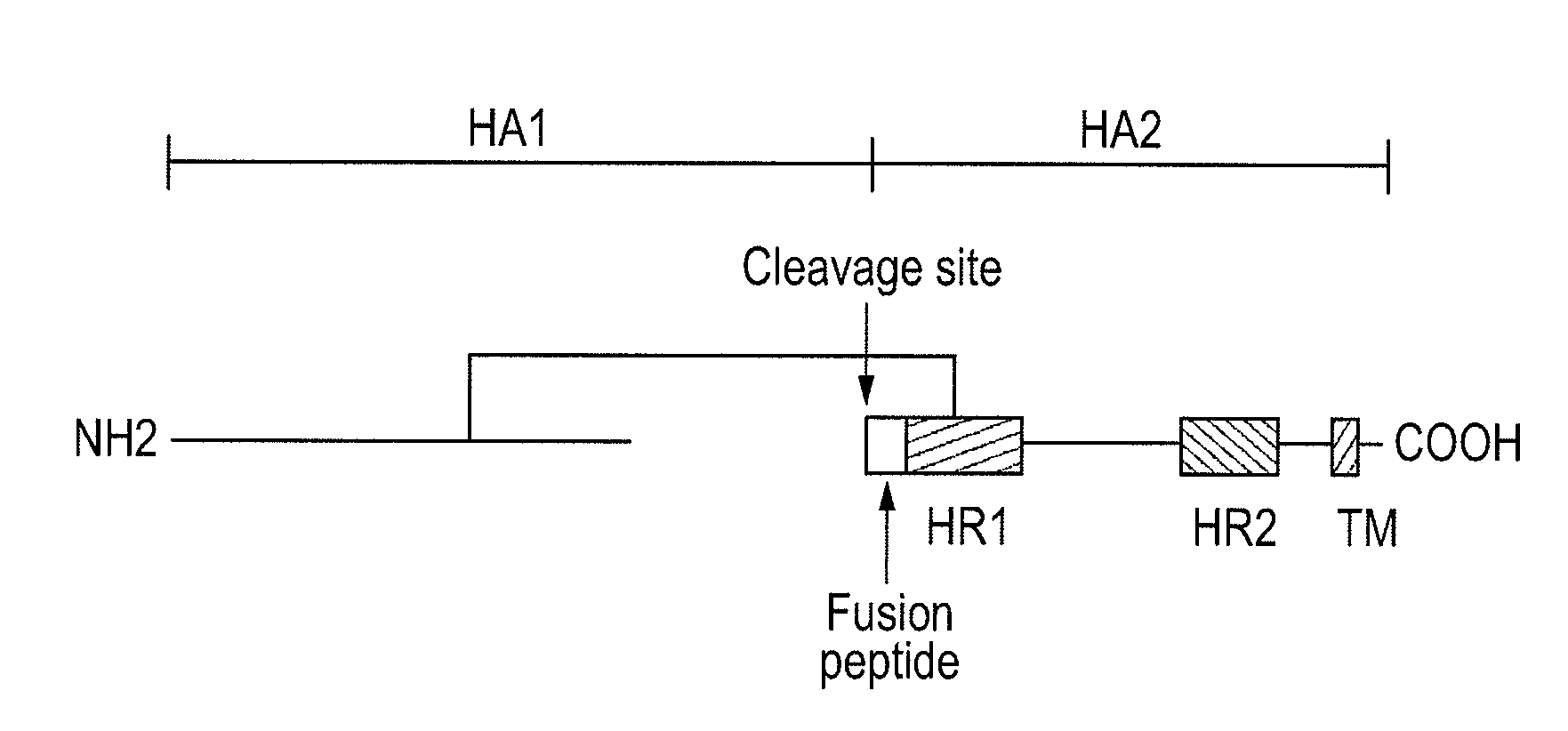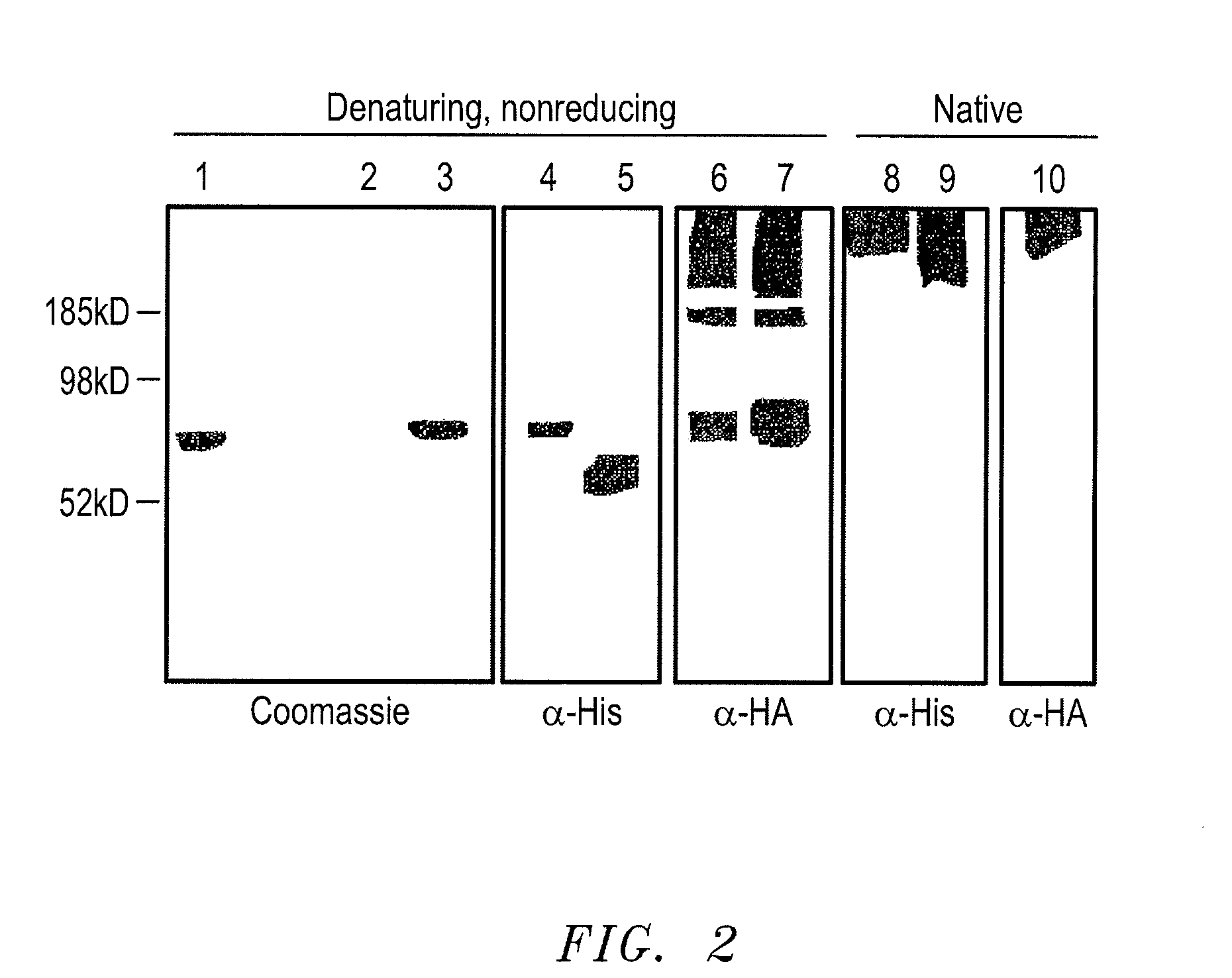Recombinant Influenza H5 Hemagluttinin Protein And Nucleic Acid Coding Therefor
a technology of hemagluttinin and hemagluttinin protein, which is applied in the field of molecular biology, genetics and virology, can solve the problems of inability to transfer the results of human trials to human trials, inability to protect humans with vaccines, and traditional and reverse engineering approaches
- Summary
- Abstract
- Description
- Claims
- Application Information
AI Technical Summary
Benefits of technology
Problems solved by technology
Method used
Image
Examples
example 1
[0147] Expression of a soluble native-conformation H5 HA protein. Influenza HA proteins are synthesized as inactive precursors (HA0) that are cleaved by host-cell proteases into the biologically fusion-active HA1 and HA2 domains (FIG. 1A, next page). HA1 is extracellular and disulfide-linked to HA2. Influenza virus HA proteins are type I glycoproteins existing as trimers, with two 4-3 heptad repeat domains at the N— and C regions of the HA2 domain (HR1 and HR2), which form coiled-coil α-helices. These coiled-coils become apposed in an antiparallel fashion when the protein undergoes a low pH-induced conformational change into the fusogenic state. There is a hydrophobic fusion peptide N-proximal to the N-terminal heptad repeat, which is thought to insert into the target cell endosomal membrane, while the association of the heptad repeats brings the transmembrane domain into close proximity inducing membrane fusion (Baker et al., 1999). This mechanism has been proposed for a number of ...
example 2
[0153] Determination of serum HAI titers in human subjects. The serum antibody response to influenza virus is commonly measured using the hemagglutination inhibition (HAI) test: an HAI titer of ≧40 is deemed protective, or alternatively, a 4-fold increase in HAI antibody titer is considered significant (Hobson et al., 1972). Serum samples will be collected from HA-immunized mice to assess the serological response for comparisons with T-cell immune responses. Previously, the inventors tested subjects enrolled in a comparative influenza vaccine trial that compared trivalent inactivated influenza vaccine (TIV) with live-attenuated influenza vaccine (LAIV) for serum antibody titer to each strain of influenza virus by the HAI method, using the same antigens as those in the vaccines. The strains of influenza A / H1N1 and influenza A / H3N2 used in the two vaccines were the same, but the influenza B strains were different. Geometric mean titers (GMT) were determined in each vaccine group and w...
example 3
[0160] As discussed above, the inventors have generated an H5 influenza HA truncated, soluble construct (H5 HAΔTM) that is expressed at high levels in cultured mammalian cells, allowing for the production of highly pure, conformationally intact H5 influenza HA protein. The H5 HAΔTM construct is highly expressed in our system, with a typical yield from a 30 ml culture of 0.5-1 mg.
[0161] Trypsin digestion of H5 HAΔTM produces two products with molecular weights consistent with HA0 (˜62 kD) and HA1 (˜39 kD). FIG. 11 shows the effect of increasing concentrations of trypsin on the cleavability of H5 HAΔTM. At low concentrations of trypsin, only the HA0 product is detected. Increasing concentrations of trypsin cleave the HA to produce increasing amounts of HA1 (˜39 kD). HA2 [˜24 kD] is not visible on this particular blot. These results show that H5 HAΔTM is resistant to digestion, and suggesting that it forms a stable trimer.
[0162] Glycosylation of the H5 HAΔTM protein was assessed. A m...
PUM
| Property | Measurement | Unit |
|---|---|---|
| full length | aaaaa | aaaaa |
| nucleic acid sequence | aaaaa | aaaaa |
| nucleic acid | aaaaa | aaaaa |
Abstract
Description
Claims
Application Information
 Login to view more
Login to view more - R&D Engineer
- R&D Manager
- IP Professional
- Industry Leading Data Capabilities
- Powerful AI technology
- Patent DNA Extraction
Browse by: Latest US Patents, China's latest patents, Technical Efficacy Thesaurus, Application Domain, Technology Topic.
© 2024 PatSnap. All rights reserved.Legal|Privacy policy|Modern Slavery Act Transparency Statement|Sitemap



